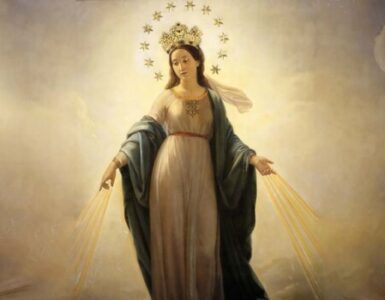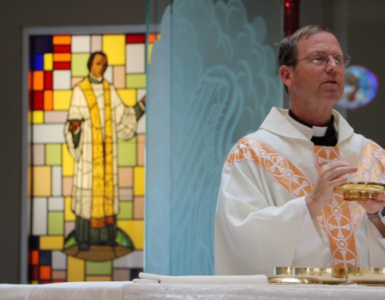A few months ago, we printed Fr. Dave Nix’s critical warning about the series The Chosen.
In a media world saturated by anti-Christian messages, it is natural and tempting to gravitate toward a show that deals with the topic of salvation or purports to celebrate the gospel. Many viewers have reported that the show brought them closer to Christ or introduced them to the gospel in a fresh or impactful way.
However, as Fr. Nix pointed out, there are several major issues with the show’s theology. Many have to do with its portrayal of Our Lady, just as many of the major errors of Protestantism have to do with rejecting Marian dogmas and Our Lady’s exalted status as Mediatrix of all Graces. This is not surprising, given that the director is a practicing Protestant whose profession of faith implicitly includes these very errors that are now illustrated on the screen. Media interpreting the gospels through a Protestant lens is bound to reflect Protestant theology.
Christ is inseparable from His Mystical Body (the Church). Therefore, a wrong conception of the Church necessarily means a wrong conception of Christ, and vice-versa. Protestantism professes an erroneous view of the Church, and therefore an erroneous view of Christ Himself. A more detailed breakdown of the issues with the series can be viewed here.
We see a similar principle at play, albeit to a greater degree, with regards to the scandalous 2018 Met Gala and subsequent exhibit Heavenly Bodies. While some of the art rightly reflected the beauty of the Faith, it was accompanied by outright blasphemous women’s dresses fashioned after clerical vestments, including a bishop’s miter.
The catechism defines blasphemy as follows:
“Blasphemy is insulting language which expresses contempt for God, either directly or through His saints and holy things” (emphasis added).
It continues:
“Contemptuous or abusive language against God, scoffing at the true religion, or ridiculing sacred ceremonies—all these are blasphemous” (emphasis in original).
Many argued that the Gala had a net impact for good because it brought Catholicism into the public sphere. At one level this is true—mockery does tend to have the effect of drawing attention. But does that mean we should support the mockery? The wrong kind of attention is worse than no attention. As St. Augustine says, “Some are ashamed to deny Jesus Christ, but do not blush to deny the maxims of Jesus Christ.”
So why does this matter? Shouldn’t we just accept the good and ignore the bad?
Spiritual director Dom Hubert van Zeller says no: “It is better not to reach Our Lord at all than to reach a parody of Our Lord. It is simply not true that whatever draws attention to religion and spirituality is bound to be to the good.”
We know that the devil can twist holy words and things, even Scripture, in order to produce disastrous effects. In fact, this is where the devil can do the most damage. His master stroke of deception will be a counterfeit Catholicism, the forewarned “ape of the Church,” that will characterize the end days and deceive even the elect.
Yes, God can use any unpredictable moment to plant seeds to bring people to Himself. He can reach out to anyone in the direst or most sinful circumstances and permit evil to bring about a greater good. But that does not mean that those of us with eyes to see should promote error. Catholics, who understand the sanctity of the Faith and its symbols, know better than an atheist who may have wandered into the Met Gala and been inspired. A mockery of the Faith is always a net negative.
The “close enough” mindset does not hold water when examined against the Church’s long tradition of preserving the Magisterium as whole and inviolate.
It takes only one drop of poison to corrupt. Think of the definition of heresy, from the same catechism: “heresy is the formal and deliberate denial or doubt of any revealed truth of the Catholic faith” (emphasis added). Apostasy is the “total rejection of faith,” but equally soul-killing heresy only requires rejection of one revealed truth.
You have to be smart to be a heretic. You have to have knowledge of the Faith. You often profess a large portion of the Faith. But then, you introduce as little as just one error. An error that mischaracterizes and warps the rest of the Faith. Analyzed by percentages, it can be argued that Martin Luther believed in most of the Church’s teachings. Close enough?
The most concrete way in which the Church has made clear that “close enough is not enough” is the publication of the Index of Prohibited Books (issued mid-sixteenth century through 1966). In her guardianship of souls, the Church has seen fit to ban particular books that were evaluated by Catholic theologians and deemed dangerous to faith or morals. Catholics were forbidden from reading or possessing these books under pain of sin.
Fr. Francis Sales Betten, SJ (1863-1942) explains in his treatise on the Index that the Church “restrain[s] them from the reading of bad books as from a deadly poison.”
He goes on:
“Bad literature is one of the worst enemies of mankind. The Church can never allow it to corrupt the hearts of her children or to undermine the foundation of their faith, without at least raising a warning voice.”
The Index arose at the time of the Protestant Reformation, when many theological errors rampaged in print across Europe, threatening and confusing souls. Early Indices condemned the works of Martin Luther, John Calvin, and other likely candidates. As common literacy flourished, the Index provided a safe guide for Catholics to guard their faith against pernicious and often attractively packaged errors. By the time Fr. Betten was writing (1909), the Index contained many works of literature and science that Catholics were likely to encounter, largely defending against the various iterations of humanist errors of the past several centuries.
Some condemnations were obvious, such as the manifestly heretical Happiness in Hell by a man ironically named St. George Jackson Mivart.
Others may not have seemed so obvious: David Friedrich Strauss’s Life of Christ, for example, at first glance appears to be an interesting, potentially edifying historical study of Jesus’ life. This veneer of respectability is what made this work all the more dangerous. Strauss was a liberal Protestant theologian and a proponent of the “historical Jesus,” an erroneous school of biblical criticism that went so far as to deny Christ’s divinity. So, while the reader may have learned some interesting historical facts about Jesus, they were at the same time poisoned with a damning heresy.
Fr. Betten warns that modern man is no less susceptible to error, despite his outsized pride to the contrary:
“The inventions, discoveries and progress of our times can introduce no change in this respect. The human mind is still as prone to err and as much subject to the persuasive influence of books as it ever was. Good books are as useful today as they were in olden times, and objectionable writings have the same deplorable effects they had a thousand years ago.”
Another example from the Index is the blasphemous 1955 novel The Last Temptation of Christ, later made into a movie starring Willem Dafoe (1988). The book scandalously portrays Jesus facing temptations of the flesh. This portrayal encompasses many Christological errors (including crypto-Arianism) by overemphasizing Christ’s human nature and suggesting that His human nature was corrupt or corruptible. The Church decided to place the book on the Index of Forbidden Books.
Atheist friends have praised the movie to me, even claiming it is the only thing that made them consider Christianity. Unfortunately, it portrays a mockery of the truth. Can God potentially use this movie, riddled as it is with error and scandal, to bring an atheist closer to the truth? Perhaps. But as a Catholic, I cannot watch or endorse the movie because I know better. I have the correct view of Christ, as defined and divinely protected by the one, holy, Catholic and apostolic Church. Those in error may perhaps find bad books as stepping stones toward truth, but Catholics cannot move backwards from truth to error. Faith and grace are gifts that must be protected.
One may next argue that, because of this possession of the whole truth, Catholics are immune to the effects of reading bad theology. In his book Christ and the Powers of Darkness, Fr. J Godfrey Raupert addresses this objection:
“We may read a particular statement and attach little importance to it at the time. We may think that we shall forget it before long. But as a matter of fact, nothing that we read or have read in the course of our lives is ever wiped out from the tablets of our minds. The subconscious storehouse has received it and retains it, and some day, by the association of ideas, worked upon by evil spirits, it will emerge from the storehouse; it will present itself in a still more attractive dress, and it will trouble and torture the mind and even tend to destroy faith.” (emphasis added).
Some will argue that ambiguous phrases in books should be given the benefit of the doubt. As Fr. Betten says, “If the author has to be called upon to explain the meaning of his book, he should have left it unprinted.” Ambiguity always serves the devil.
How to Safeguard Our Souls
Fr. Raupert, an expert in psychology and spiritual warfare, provides some “soul safeguards” against demonic attack. First on his list is “avoid desultory and indiscriminate reading,” which he identifies as the “greatest hindrance to spiritual growth.”
He warns:
“We do not eat all sorts of food. We select the kinds of food that we know to be pure and nourishing…It is precisely the same with our intellectual food…Thousands of books every year are issuing from the secular press in which the poison is distributed in the most subtle way and is called by the most pleasing-sounding names.”
If there were ever an age where the Index was more desperately needed, it’s today. In earlier times, errors were contained neatly in books. In the age of mass media, we’re constantly flooded with content in all forms, so that almost every moment becomes a judgment call. It’s a difficult battleground. Obviously not everything we read or consume will have an imprimatur. So where do we draw the line? It may help to keep in mind the Church’s general guidelines for consigning publications to the Index.
Taken from Fr. Betten’s pamphlet:
- Books defending heresies, i.e. doctrines contrary to divine revelation.
- Books derogatory to God, the Blessed Virgin, the Saints.
- Books vilifying the sacraments, the clerical or religious state, the hierarchy, the Church.
- Books professedly treating of, narrating, or teaching lewdness and obscenities
- Books teaching or recommending sorcery, spiritism, Christian Science, or other superstitions.
- Books defending as lawful or harmless, Freemasonry, divorce, Socialism, suicide, duelling.
- Those newspapers and periodicals which not merely now and then, but regularly and of set purpose, attack religion or morality, or propagate anti-Catholic views.
We can acknowledge we live in a fallen world without giving voice to error. With so many errors present in today’s media, Catholics have a duty and a unique opportunity to be a voice for unadulterated truth.
✠
Photo by Fernando Meloni on Unsplash














